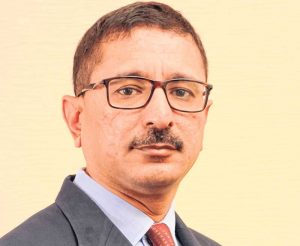http://www.freepressjournal.in/business/we-will-be-among-the-top-10-in-five-years-munish-sharda-md-and-ceo-future-generali-india-life-insurance-company/1344149
Munish Sharda of Future Generali wants to be ahead of the race in insurance
— By | Aug 28, 2018

Munish Sharda joined Future Generali India Life Insurance Company (FGI-LI) as its Managing Director & CEO in January 2014. That was a challenging time for both the life insurance industry and FGI-LI. In four years, both have made tremendous progress; FGI-LI is now looking to achieve chart-busting numbers on all fronts. Munish, in an interview with The Free Press Journal’s S. Narayanan and RN Bhaskar, talks about how FGI-LI negotiated the tough times and how he sees the way ahead.
Edited excerpts:
What steps did you take to turn the corner?
It is very costly and difficult to acquire a new customer. But if you’ve got a customer, then you need to do more with him across product or service categories. This is where we saw the opportunity. We are part of a large retail ecosystem. Customers come into our stores!
So, we went about building a truly customer-centric company. At the same time, we put in place a technology backbone, which facilitated customer transactions and took costs out of the business. We built products that the customer was able to understand very easily and were linked to his needs. This way, we reduced chances of both mis-selling and mis-buying. We also built the right distribution and created focus on the target market. It is important that you have the right platform, products and processes before you start scaling up your business.
Today, the entire organisation engages with the customer, not just the customer services department. We use a unique system, wherein any customer feedback flows into the phone app of several people in the company. We have our people tasked to resolve customer complaints and upload the system real time. Simultaneously, somebody at the back-end looks at the kind of issues being raised and someone else makes changes to processes so that those issues do not recur. I, as a CEO, get all of this feedback real-time on my phone. My leadership team is tasked to speak to three or four customers every week. That’s how you bring the customer focus, it’s a long journey, but we have seen a lot of transformation happening on that front. We launched a WhatsApp-based service about a month back, wherein a customer can pull-in whatever information he wants. You have to have a differentiated platform and the ability to deliver better experience to clients and distributors, employees, even vendors.
I am quite proud of what we’ve done in the last four to four-and-a-half years now. We have almost tripled our volumes in agency and direct channels in the last couple of years. We have also made tremendous progress in some critical areas such as underwriting quality and persistency. We have more than doubled our persistency levels in some of our channels. Our persistency was about 40 per cent four years ago, we are now at 70-72 per cent; in our direct channel and bancassurance, it is more than 85 per cent, and agency more than 70-72 per cent. We are targeting 85-90 per cent persistency. Why should anybody not pay renewal premiums when he has bought a long-term insurance policy?
Today, we are one of the big insurers in the group employee term life space. Our partners include the country’s largest small finance bank, the country’s largest co-operative bank, the country’s largest NBFC and one of the largest loan distributors. We recently signed up with American Express as a corporate agent.
It’s a snowball thing. As you do more, you get more, you do more, you get more and you expand distribution.
What is your distributor and product profile?
The agency contributes about 60 per cent of our business. About 10 per cent comes from our direct channels. Partnerships and bancassurance contribute the balance. We believe the agency has to be at the core of our business. In the long run, I think we will stabilise at 60-65 per cent between the agency and direct and 35-40 per cent between bancassurance and partnerships.
At a company level, our ticket size would be in the range of Rs 35,000 to Rs 40,000. We sell about 20 per cent ULIP and 80 per cent traditional.
Is life insurance all about protection?
Every instrument has a role to play in the financial planning. Our products come with embedded solutions; and this gives you a huge peace of mind – be it unit-linked, traditional savings or protection. One does not replace or substitute one another. What is important is the solution they provide for the customer’s need. At the same time, it is the responsibility of the insurer to ensure that the customer gets the right solution in a transparent manner.
What differentiates FGI-LI from other life insurers?
Our focus is our customer and on our ability to deliver solutions which are simpler, smarter and faster. I see us as one of the most customer-centric and tech-savvy insurer in the market.
How easy is the buying process for a particular policy? How is it priced? What is the payout structure in the plan? What are the servicing levels of the company? The customer is becoming more and more discerning. They look at the entire proposition; not just pricing of a product. That’s the differentiator.
When will FGI-LI break-even?
We are a young company; our 10 years of existence has been in the most turbulent period in the Indian life insurance sector! We reported our first quarterly profit in the last quarter of the previous year. The first year premium in FY 17-18 was Rs 992 crore.
Renewals [this year] is growing at close to 30 per cent; as we produce more and our persistency grows, profits will start flowing through. We are focused on building a profitable book. We should start seeing underwriting profits flow through, because of the work that we have done in the last couple of years.
We intend to break even [at the operating level] in FY19-20.
What are FGI-LI’s growth plans?
Our ambition is to continue to grow at a pace that is higher than that of the industry, if not 1.5-2x the industry growth. Keep participating in the distribution opportunity as and when they come up. It’s my dream to be able to build a sizeable business model around the customer base at Future Retail. We are putting things in shape there.
Where do you see FGI-LI 5-years from now?
We want to be, from a customer standpoint, amongst the best insurers in terms of customer centricity.
In addition to our proprietary distribution, we will also build selective long-term distribution on the non-proprietary side, which is profitable and sustainable. I see ourselves having a large set of customers and amongst the top 10 insurers in the market.
And we would want to be an insurer which delivered good returns on equity to shareholders.
How do you see the life industry’s growth?
The economy is growing, demographics are favorable. I am also very positive about the work the regulator has done in the last couple of years. Quite a lot of developmental work has happened. I think we will grow at least 2-2.5x of GDP growth, primarily driven by rising incomes and increasing awareness of insurance products. These two factors will drive insurance to a very different level over the nextfive years.







































COMMENTS